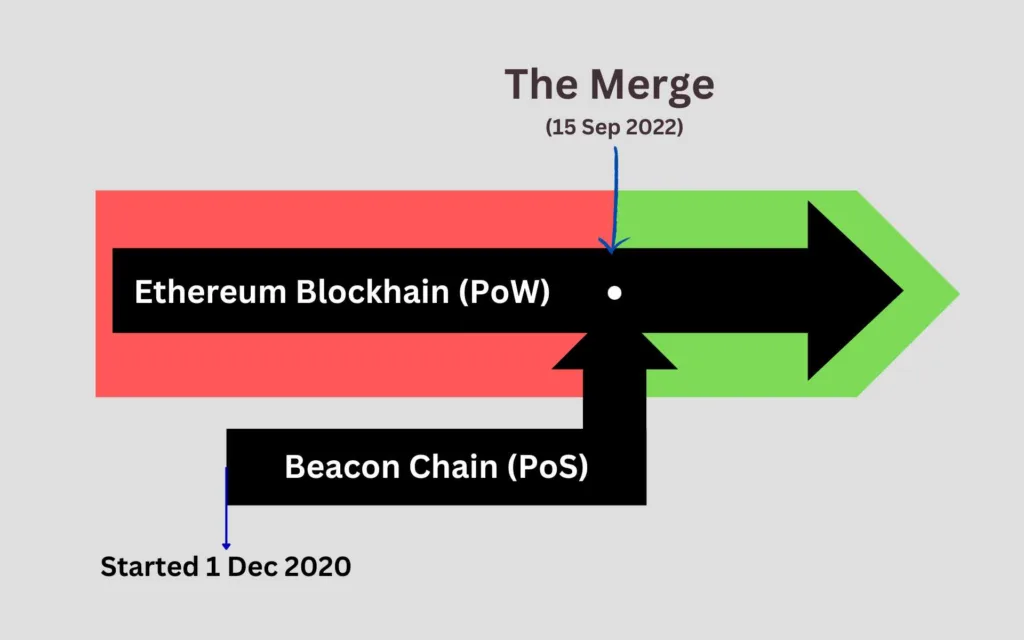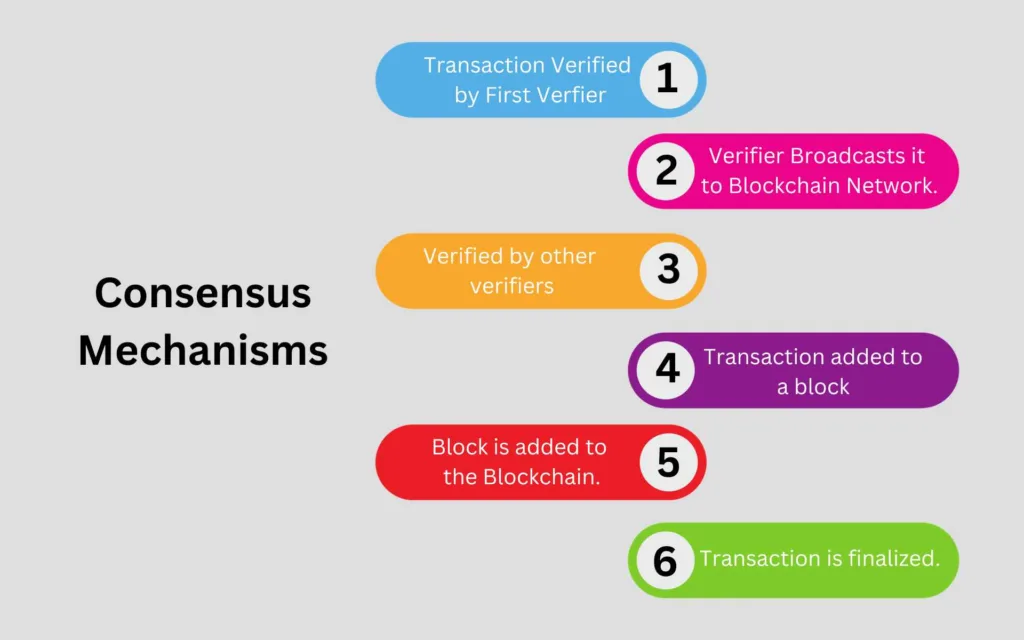Consensus Mechanisms are different ways to verify blockchain transactions by running it through multiple validators each of whom verifies them individually.
Note, that throughout the article, the terms Consensus Mechanism, Consensus Protocol and Consensus Algorithm have been used interchangeable and have the same meaning.
Table of Contents
Need for Consensus Mechanisms
Consensus Mechanisms essentially make sure that every blockchain transaction is genuine. This helps the blockchain remain secure since each user is confident that their funds are safe. Therefore, the most important job of a consensus mechanism is to ensure the safety of the blockchain.
History of Consensus Mechanisms
Consensus Mechanisms were first developed successfully using the Bitcoin blockchain where verifiers(miners). Later, as Bitcoin grew in size, there were concerns that it might be unsustainable. Other blockchains could not use its consensus mechanism (Proof of Work). This was primarily because of its high energy consumption.
The came the existence of blockchains like Algorand which was based on Pure Proof of Stake. Such blockchains were using 99.9% less energy than Bitcoin with remarkable security.

Later in 2022, Ethereum too changed from Proof of Work to Proof of Stake through a year-long event ending on 15 September 2023, called the Merge. The name was so because it merged an existing Proof of Work blockchain with a new blockchain called the Beacon Chain which was created in Proof of Stake.
How do Consensus Mechanisms Work?
Let me give you a broad overview of how consensus mechanisms work. Though there are differences, yet the basic process is all the same.
Consensus mechanisms basically need to make sure that the distributed ledger of a blockchain stays true. This is done through the following steps:
- When a transaction is initiated, it is verified by a designated verifier such as a validator(PoS) or miner(PoW).
- Then the verifier broadcasts the transaction to the network.
- Multiple verifiers, other than the first verifier, also verify the transactions.
- After the transaction is verified by a certain number of verifiers, it is added to a block.
- The block is then added to a blockchain when it has sufficient numbers of transactions.
- After a few blocks, the transaction is finalized.

Centralized vs Decentralized Consensus
Centralized consensus algorithms are the ones where decision making and authorization of transactions take place in a top down approach. A few verifiers validate all the transactions. Usually I have seen these kind of mechanisms in permissioned blockchains such as Hyperledger where even a single authority such as a company’s CEO authorizes the blockchain transactions.
In Decentralized consensus algorithms, the number of verifiers are higher, with more power and they are often geographically distributed. Here, the transactions are verified in a democratic process. Usually some kind of mechanism is put so that they do not act in a fraudulent manner.
Sybil Resistance Mechanisms vs Consensus Mechanisms
Sybil Resistance Mechanisms are those which prevent a majority takeover of a blockchain’s verifiers. These takeovers are in the form of attacks called 51% attacks.
10 Different Types of Consensus Mechanisms with Examples
Here is a list of 10 different consensus mechanisms that are used in major blockchains.
Summary
| Consensus Mechanism | Pro | Con | Example |
|---|---|---|---|
| Proof of Work | Increased security | High Energy Consumption | Bitcoin, Ethereum Classic |
| Proof of Stake | Highly efficient and secure | Needs a high number of validators to be secure. | Ethereum, Algorand |
| Proof of Delegated Stake | Faster speed | Lower no of verifications | EOS, Tron |
| Proof of History | Very high speeds (100k TPS) | Prone to blockchain halt. | Solana |
| Proof of Authority | Faster and Cheaper | Less Democratic | VeChain |
| Proof of Delegated Authority | Delegated decision-making | Less Democratic | Private blockchains |
| Proof of Elapsed Time | Low energy consumption | Validators are idle most of the time. | Hyperledger Sawtooth |
| Proof of Burn | Easy to operate | Unsustainable when coins get short | Slimcoin |
| Proof of Capacity | Easy to use | Prone to hackers | Signum |
| Proof of Contribution |
1. Proof of Work (PoW)
This was the first consensus mechanism to come into existence with Bitcoin’s blockchain. Here, transaction verifiers, also called as miners, run complex calculations to guess the nonce value which is unique for every transaction. These nonce values are obtained from the hashing function with the following inputs (non-exhaustive list):
- Transaction amount
- Public address of receiver
- Private key of sender
- Hash of previous transaction
Examples of Proof of Work Blockchains:

- Bitcoin
- Dogecoin
- Ethereum Classic
2. Proof of Stake (PoS)
In this consensus mechanism, the transactions are verified by validators who have to stake some collateral (32 ETH in Ethereum) to be able to sign transaction. Any mistake or faulty behavior of the validators can lead to a partial or total loss of their stake.
The working of Proof of Stake is similar to Proof of Work but there is no need to perform complex calculations in the Proof of Stake consensus mechanism.
Examples of Proof of Stake Blockchains:
- Ethereum
- Algorand
- Avalanche
3. Proof of Delegated Stake (PoDS)
This is a special type of blockchain consensus protocol where instead of using their own funds to stake, validators receive funds from people called delegators. Since these delegators fund the stake for the validator, they are entitled to share the rewards that the validator generates.
A special type of election is conducted to elect witnesses (delegates) who take the role of validators. Only those who own the native Governance token are allowed to vote.
Example of Proof of Delegated Stake Blockchains:
- Tron
- EOS
4. Proof of History (PoH)
In Proof of History, which was developed by Solana, blocks are time-stamped using function called Verifiable Delay Function(VDF). These timestamps record at what point a block was validated and also record the order of the blocks. The VDF is designed to be a computation intensive function and resists attacks from the outside.
Proof of History cannot work alone and it needs another blockchain consensus to verify individual transactions, which is in the case of Solana is Proof of Stake.
These blockchain consensus has a dual layer of protection and is very effective against Replay Attacks.
In the case of Solana, Proof of History achieves a theoretical transaction speed of 100k per second.
5. Proof of Authority (PoA)
In this type of blockchain, the command structure follows a top-down approach. Here, transaction verifiers are selected and authorized to validate transactions. Selection can be from done by a top authority such as leadership of an organization or through a vote by token holders.
Example of Proof of Authority consensus:
VeChain uses this consensus mechanism to select its 101 blockchain validators which are called as Masternode Operators. This helps VeChain operate its blockchain in an energy efficient way. As per its claims VeChain uses only 0.04% of energy as compared to other blockchains.
6. Proof of Delegated Authority (PoDA)
In the proof of delegated authority consensus mechanism, the validators are selected by the key decision makers. This is opposed to Proof of Authority where a decision maker is directly responsible for validating blockchain transactions.
The consensus mechanism is mostly seen in private blockchains where day to day decision making is done through and recoded on blockchains.
7. Proof of Elapsed Time (PoET)
In Proof of Elapsed Time, every validator generates a random waiting (using a function) time after which they are allotted a block. They then add transactions to the block and then the next validator whose waiting time is overtakes the creation of the next block.

It was invented by Intel Inc in early 2016 in collaboration with Hyperledger, IBM and Linux Project. The primary aim of this project is to reduce the energy consumption in Proof of Work blockchains.
8. Proof of Burn (PoB)
In Proof of Burn, the validators are required to burn the native coins to be able to verify transactions. The greater the number of tokens burnt, the higher will be their share in validating transactions. Tokens are sent to a dead irrecoverable wallet for burning.
It was invented by Iain Stewart.
Tokens are mostly sold to validators during ICOs or can be bought from the market.
Since, after buying tokens, the validators already have a stake in securing the blockchain, it creates a mental barrier against any ill thought plan to sabotage the blockchain.
Example of Proof of Burn consensus mechanism:
- Slimcoin
9. Proof of Capacity (PoC)
In this type of consensus mechanism, local hard drive of the validator is used to store a list of possible solutions to the function that is run for validation. If there is a large space on the computer, a larger list of solutions can be stored and therefore a larger probability of discovering the right solutions and add it to blocks.
One key disadvantage of Proof of Capacity is that a hacker could obtain an virtual computer on the cloud to have infinite storage and therefore legally could mine all or a major chunk of the crypto alone.
Example of Proof of Capacity consensus mechanism:
- Signum
- Chia
- Spacemint
10. Proof of Contribution (PoCo)
Here, the contribution of users and their behavior is recorded and those with the highest contributions in a consensus round are rewarded a block. The benefit is that it does not rely on a cryptocurrency to become a validator unlike Ethereum.
Proof of Contribution consensus mechanism was built by Hongyu Song, Nafei Zhu, Ruixin Xue, Jingsha He, Kun Zang and Jianyu Wang to secure Intellectual Property Rights without the use of a cryptocurrency.
Frequently Asked Questions
What is the best crypto Consensus Mechanism?
In my experience, if you prefer safety, Proof of Work is the best. If you prefer centralization, permissioned mechanisms like Proof of Authority is best. If you prefer a lean consensus mechanism with safety, Proof of Stake works best.
Is Bitcoin based on Consensus Mechanism?
Yes, Bitcoin was the first blockchain which had established the practical usage of a consensus mechanism which was Proof of Work on which it is based.
What is Ripple’s Consensus Mechanism?
Ripple uses the Federated Byzantine Agreement Model for its consensus and it is called as RPCA (Ripple Protocol Consensus Algorithm).
Which Consensus protocol is fastest?
The fastest consensus protocol as far as I have seen is possible with Proof of Authority since it requires much lesser number of confirmations than other consensus protocols.
Ethereum changed its Consensus Mechanism from what to what?
In 2022, Ethereum changed its consensus mechanism from Proof of work to Proof of Stake. This reduced its energy consumption by 99.9%.
Which Type of Novel Sybil-resistant Consensus Mechanism Does Berachain Use?
Berachain uses Proof of Liquidity protocol which is based on the principle that higher the liquidity, higher will be the trust on the liquidity provider.
What is the concept of Consensus Mechanism in Blockchain?
In blockchain, the concept of consensus mechanism tests the validity of every transaction and then spreads the valid transaction to other nodes for multiple verifications. This helps in avoiding a single point failure for authentication.